
|
The Sentry™
Card# MTU-017

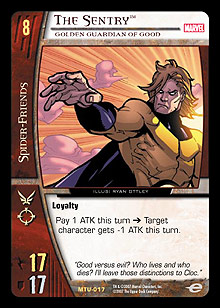
While his stats aren’t much bigger than those of the average 7-drop, Sentry’s “Pay ATK” power can drastically hinder an opponent’s attacking options in the late game.
Click here for more
|
|
|

|
|
|

 |
 |
|
|
| |
|
Welcome to the first article of my new column. The focus of this column is similarity. An apparent hallmark of the Vs. System is the usage of key mechanics as a common thread between different cards—cards that do the same thing in a slightly different way, or cards that have a common mechanic but are drastically different in other ways. In some cases, these cards work well together, and in other cases they don't. This column is all about the similarities and differences within these groupings of cards: which ones are the best, which ones are the worst, which ones are best for specific purposes and for Constructed and Limited play. I'll touch on which selections from each category are suitable for splashing into decks or designing a deck around, and in a few rare cases, I'll detail which ones aren't worth playing at all.
 For today, I want to look at one of my favorite groups of cards: Heroes United, Unlikely Allies, Mutant Nation, Common Enemy, and Marvel Team-Up. All five are plot twists, and the mechanic they all share is the following effect: For today, I want to look at one of my favorite groups of cards: Heroes United, Unlikely Allies, Mutant Nation, Common Enemy, and Marvel Team-Up. All five are plot twists, and the mechanic they all share is the following effect:
Ongoing: Cards you control, as well as cards in your hand, deck, and KO'd pile that have either the [team affiliation 1] or [team affiliation 2] team affiliation are considered to have both team affiliations.
At first glance, a beginner player might not see the worth of these cards. I've seen people kind of look at them and pass right over them, and I've also seen them bashed heavily by pseudo-experienced players. If I had to choose a single group of cards as the most under-rated in Marvel Origins, this would be it. The utility these cards can provide is incredible. Consider the full capabilities of these cards.
First up, the obvious: with shared team affiliations across the board, you're able to reinforce and team attack with greater ease. Sure, tactics can make reinforcements and team attacks relatively easy; skill is great, so I'm not promoting these cards as a crutch or replacement for skill. What I am promoting them as, however, is a set of tools that can make creative and complicated team attacks and reinforcements—ones that the opponent won't even see coming—possible.
Sure, being able to team attack and reinforce at will is cool on its own, but how about if you use Burn Rubber? With a united set of team affiliations, Burn Rubber suddenly becomes even more powerful than normal, allowing one character on a given turn to be part of any team attack, or to reinforce virtually any attacked character (assuming the slot on the field needed for reinforcement isn't already occupied). Successful decks in the Pro Circuit Qualifiers are starting to show how powerful Burn Rubber can be, and the team affiliation effect boosts its already-high utility. If your opponent learns that you can reinforce anyone, anywhere, completely on the fly with any character of your choosing, and that you can team attack almost anyone from any initial board position, he or she is going to have to think very carefully about how and what they play.
Cards that are costed via the "Recruit [this character] only if you control a [team affiliation] character" line are easier to play, as you're able to circumvent the intended obligation to a specific maintained board presence. Cards that are pseudo-costed in the same way will get their additional effects more often, as well.
Last up, since these cards also affect the cards in your deck and hand, there are some tricks you can pull that opponents might not see coming. Some are quite powerful; others are just sort of interesting. Let's examine what each card specifically accomplishes.
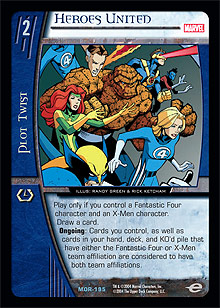 Heroes United Heroes United
Fantastic Four : X-Men
Heroes United and Common Enemy are the two best cards in the group, if taken from a perspective of control and reliability. The chief reason for this is Signal Flare—with either of these Plot Twists in play, it's likely that you'll be able to pull basically any character you want off of Signal Flare. Not only do you get a huge boost in what you can search for, but you also get coverage on paying Signal Flare's cost. Since Heroes United replaces itself via the one card it lets you draw, there's not much conceivable reason to exclude it from any deck teaming the Fantastic Four with the X-Men.
From the perspective of field presence as a requirement for recruitment, you'll have an easier time recruiting Professor X, World's Most Powerful Telepath; Rogue, Powerhouse; Human Torch, Hotshot; Human Torch, Super Nova; and the mighty Thing, Heavy Hitter. No other card from the group provides so much help to costed recruiting (based on field presence), simply because the Fantastic Four has more characters costed in this way than any other current team affiliation in Marvel Origins. The X-Men's two characters are, however, a close second.
From the pseudo-costing side, you're going to see more bang for your buck from Professor X, Charles Xavier; Professor Xavier's Mansion; Mr. Fantastic, Scientific Genius; Thing, The Ever-Lovin' Blue-Eyed Thing; Antarctic Research Base; and Baxter Building. The standout in my mind is Professor Xavier's Mansion, which is utterly nasty if you can sustain it (a task Heroes United will help you to accomplish).
Lastly, in the little tricks department, a fun one that springs to mind is the recruitment condition of Wolverine, Logan. Not only will you be able to pay the cost of revealing an X-Men character card from your hand with greater ease, but you'll also be able to misdirect your opponent. "Want to see my X-Men card? YOU CAN'T! LOOK! IT'S THING! HE'S AN X-MAN NOW! AHH-HA-HA-HA!" and whatnot. Probably not nearly as entertaining or evil as it seems in my head, but potentially useful if you want to protect information and keep your opponent off-balance.
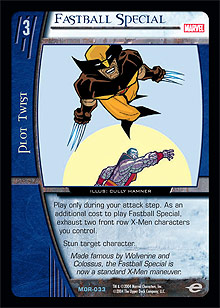 Oh, and there's that little thing about sharing Children of the Atom. That's uhh . . . that's pretty horrendously game-breaking. And Thing hurling Human Torch into battle via Fastball Special is both a pretty sweet visual and a very effective way to kill someone . . . though technically Alicia Masters would be just as effective as a projectile. I know that design circumvented the "attacking the blind girl" issue, but I think they missed the "roll up the blind girl into a ball and throw her at people" issue. Oh, and there's that little thing about sharing Children of the Atom. That's uhh . . . that's pretty horrendously game-breaking. And Thing hurling Human Torch into battle via Fastball Special is both a pretty sweet visual and a very effective way to kill someone . . . though technically Alicia Masters would be just as effective as a projectile. I know that design circumvented the "attacking the blind girl" issue, but I think they missed the "roll up the blind girl into a ball and throw her at people" issue.
Heroes United is great. Played defensively in a direct damage deck, you get to recruit Human Torch with greater ease. You can search for any X-Men character you want via Signal Flare, save any FF character via Children of the Atom, and use Professor Xavier's Mansion to keep pressure on the opponent by eating away at his or her hand so he or she can't maintain the offense needed to overcome your direct-damage sources. I don't even want to think of the possibilities that the X-Men can provide with Cosmic Radiation—definitely a doable deck with a lot of potential in Constructed.
Unlikely Allies
Doom : X-Men
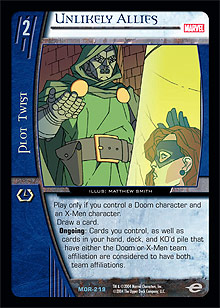 This pairing is made great simply through of the power of Doom. Children of the Atom is one of the standout cards in Marvel Origins, and one of the only weaknesses of Doom decks is their reliance on Doom. It's not hard to see where I'm going with that point, is it? This pairing is made great simply through of the power of Doom. Children of the Atom is one of the standout cards in Marvel Origins, and one of the only weaknesses of Doom decks is their reliance on Doom. It's not hard to see where I'm going with that point, is it?
Beyond that, Doom doesn't have any characters that require anything but Doom himself on the field, which is unfortunate but understandable, given that Dr. Doom's world tends to revolve around himself. The one pseudo-costed effect you'll be able to take advantage of more often is Doom's Throne Room. With a maintained Doom field presence, the card doubles in power, and this can be quite useful, since it's an early-game card. Doom characters in the early game are weak; the prime early drops, like Boris, aren't even cards you'd necessarily want to see in-hand in the first turn or two, anyway. Most Doom decks solve this by playing cards like Mystical Paralysis and Robot Sentry to slow down other decks, but since the X-Men are so good in the early game, a combination of these two teams could really work. In the mid and late game, your control cards will continue to provide more protection. In a normal Doom deck, Mystical Paralysis loses some utility as the game goes on. However, with Unlikely Allies in play, you can continue using it to protect your small characters and then use them to fill the requirement of Professor Xavier's Mansion for even more control over the opponent. Very cool.
From a "small tricks" perspective, you'll be able to splash Wolverine, Logan pretty easily, just like in the case of Heroes United. Considering that a big use of Unlikely Allies is to back up Doom's early-game weakness with bigger hitters from the mutant side, Logan's a highly important element to a Doom deck that tries to answer the early-game problem with offense instead of control.
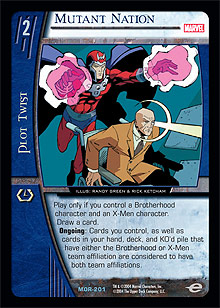 Mutant Nation Mutant Nation
Brotherhood : X-Men
Ok, so we've already established that having the X-Men on your side in a shared-team situation means you can use Children of the Atom on basically anything and get some more use out of Professor Xavier's Mansion. With all the high-powered weenies available to the Brotherhood, Professor Xavier's Mansion is even more valuable, if for no other reason than that an aggro Brotherhood deck will typically swarm the table. Sure, Charles might not appreciate Toad and the gang running amok in the Mansion, but those guys sure know how to get things done in there.
From a recruitment point of view, you'll again see easier play of Professor X, World's Most Powerful Telepath and Rogue, Powerhouse, but you'll also have an easier time getting Magneto, Lord Magnus onto the table. From a pseudo-costing perspective, Avalanche, Dominic Petros will be a bit easier to play, and since he's more of a splash character than something you'd want to plan on using perpetually, he fits quite nicely.
Where a Brotherhood/X-Men deck really benefits from Mutant Nation, though, is in the use of the Brotherhood direct damage plot twists (War on Humanity, Mutant Supremacy, and The Mutant Menace). Children of the Atom keeps your Brotherhood characters alive to count towards the effects of the plot twists, while Fastball Special serves an offensive-minded but similar purpose—taking out the big threats with even scrawny little weaklings like Toad, and using Destiny to get the job done (meaning the "deadly blind woman who can take out anyone on the board" count is now up to two).
My personal favorite trick? Mutant Nation; Savage Land; Team Tactics; and Cyclops, Scott Summers or Nightcrawler, Kurt Wagner. The result? An attacker with an absolutely ungodly ATK and 0 DEF that can't be stunned when it goes on the offensive. Nice.
 Common Enemy Common Enemy
Fantastic Four : Doom
Doom is likely the weakest of the available teams with whom to share an affiliation, simply because the affiliation-sharing plot twists don't help him with Sub-Mariner and Volcana. Doom decks also aren't as team-oriented as others. However, the Fantastic Four is arguably the best affiliation to team with, due in significant part to Signal Flare and Thing, Heavy Hitter. The end result is that Common Enemy isn't terrible. By running such a deck, you immediately get double the use out of A Child Named Valeria, which is great, because the end reward is a potentially moderate utility card becoming a very high-utility card.
You also get a lot of options. As stated before, the Fantastic Four has the most characters of any team affiliation that require a same-team board presence to be recruited and a substantial number of support cards that are pseudo-costed with the same condition.
I wouldn't personally team the FF with Doom. There's been some limited success in the PCQs, and the deck certainly can work, but the two teams just don't seem to have the synergetic potential that the other team-up options present. Not a bad pick, but still probably my last pick out of the bunch, at least in Constructed.
Marvel Team-Up
Wildcard : Wildcard
Marvel Team-Up is neat, allowing you to simulate the pairings offered by the other cards or to create pairings of team affiliations that wouldn't otherwise be a possibility. The cost? Well, the threshold cost is the same (nice and affordable at just a measly 2), but it doesn't allow you to draw a card when you play it. As such, if you're playing a pair of team affiliations that can benefit from one of the other four affiliation-sharing plot twists, you're obviously going to want to go with those. But if you're not, or for some reason you really need the redundancy of another four cards, then this is ideal.
The only major single-card synergy Marvel Team-Up can accomplish is allowing you to splash Nimrod into a deck, since it's the only affiliation-sharing card that can share the Sentinel affiliation. Sentinels don't tend to team well with other affiliations anyway, so I don't think it's a particularly remarkable card in Constructed.
All of the above cards are pretty good in Constructed, and each can be the linchpin in at least one strategy strong enough to build an entire deck around. Except for Marvel Team-Up, they replace themselves when played, and they're low-cost, so their high potential utility can be exploited by turn 2. There are a lot of neat specific tricks, such as sharing team-specific plot twists with teams that normally wouldn't be able to use them (Children of the Atom, Signal Flare, or the previously-lauded and hilarious Fastball Special), and you can get a lot more ease of use out of cards you'd be running anyway but would normally need to do a bit more work for.
In Limited, the cards shine even more. I'd consider any one of these to be first-round picks in a draft. You'll so often end up playing a spread of several team affiliations in a draft deck that being able to improve your rate of team attacking and reinforcing is a massive asset—especially when it doesn't cost you a card of hand presence! On that note, Marvel Team-Up will cost you a card (because it doesn't replace itself), but since it's the ultimate wild card in the team sense, it's totally worth it. Upon first seeing these cards, my immediate thought was "those were made for the limited format". They lose utility in the specific sense of combos—you won't be running a deck packed with four Children of the Atom, four Fastball Special, or four Signal Flare—but they make up for it in general team attack and reinforcement support.
Though Marvel Team-Up might not be as specifically important for Constructed now as the other four cards, I don't see a card like this being reprinted in the near future—it's simple, does what it does, and that's all there is to it. Unless a card is released that can unite three teams at a time, watch for this card to consistently rise in demand with each new set released, since each new set brings more team affiliations and thus more potential for Marvel Team-Up. I'm not sure if such a lightning bolt will strike twice—Marvel Team-Up could be quite a sinkhole for player's wallets a year from now, if you know what I mean. I'm winking while writing this.
So, if you're a fan of the team affiliation sharing cards, hopefully I've given you some arguments to continue justifying their use. If you haven't liked them in the past, maybe you've seen something here to convince you otherwise. As always, any questions or comments can be sent to Jason@metagame.com.
Thanks for reading! |
| |
| Top of Page |
|
 |
|
|
 |